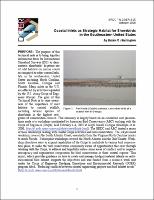Please use this identifier to cite or link to this item:
https://hdl.handle.net/11681/8756| Title: | Coastal inlets as strategic habitat for shorebirds in the southeastern United States |
| Authors: | Harrington, Brian |
| Keywords: | Coasts United States--South Atlantic States Water birds--Habitat--Effect of dredging on Dredging Operations and Environmental Research Program (U.S.) |
| Publisher: | Engineer Research and Development Center (U.S.) |
| Series/Report no.: | Technical Note (Dredging Operations and Environmental Research Program (U.S.)) ; no.ERDC TN-DOER-E25 |
| Abstract: | PURPOSE: The purpose of this technical note is to bring together information from the International Shorebird Surveys (ISS) to demonstrate shorebirds’ keystone-use of inlet habitats on marine coasts as compared to other coastal habitats in the southeastern United States including North Carolina, South Carolina, Georgia and Florida. Many inlets in the U.S. are affected by activities regulated by the U.S. Army Corps of Engineers (Corps). The goal of this Technical Note is to raise awareness of the importance of inlet habitats to coastal wildlife, including several species of shorebirds in the highest categories of conservation concern. This summary is largely based on an evaluation and presentations made at a workshop coordinated by American Bird Conservancy (ABC) working with the Corps of Engineers (Corps), held February 1-4, 2005 at Jekyll Island, Georgia (Guilfoyle et al. 2006; http://el.erdc.usace.army.mil/dots/coastalbirds.html). The ERDC and ABC hosted a series of three workshops dealing with coastal Corps activities and bird conservation. The Jekyll Island workshop covered the South Atlantic Coast, essentially from the Virginia-North Carolina border to south Florida. Subsequent workshops covered the North Atlantic and the Gulf Coasts. Workshop objectives were to expand capabilities of the Corps to contribute to various bird conservation plans, to make the bird conservation community aware of opportunities that exist through working with the Corps, to address and hopefully reduce some areas of conflict, and to improve interagency and organization cooperation for bird conservation in these coastal regions. This report, which provides guidance on how to create and manage dredged-material islands as earlysuccessional bird habitat, supports the objectives and was funded from a research work unit under the Corps of Engineers Dredging Operations and Environmental Research (DOER) program titled, “Reducing conflicts between coastal engineering projects and bird habitat needs.” (http://el.erdc.usace.army.mil/dots/coastalbirds.html ). |
| Description: | Technical Note |
| Gov't Doc #: | ERDC TN-DOER-E25 |
| Rights: | Approved for public release; distribution is unlimited |
| URI: | http://hdl.handle.net/11681/8756 |
| Appears in Collections: | Technical Note |
Files in This Item:
| File | Description | Size | Format | |
|---|---|---|---|---|
| TN-DOER-E25.pdf | ERDC TN-DOER-E25 | 3.92 MB | Adobe PDF |  View/Open |